Unstructured Data: History, Need, and Applications | Desklib
VerifiedAdded on 2023/06/05
|19
|4816
|241
AI Summary
Explore the history, need, and applications of unstructured data in healthcare, marketing, fraud prevention, and customer experience management. Desklib.
Contribute Materials
Your contribution can guide someone’s learning journey. Share your
documents today.
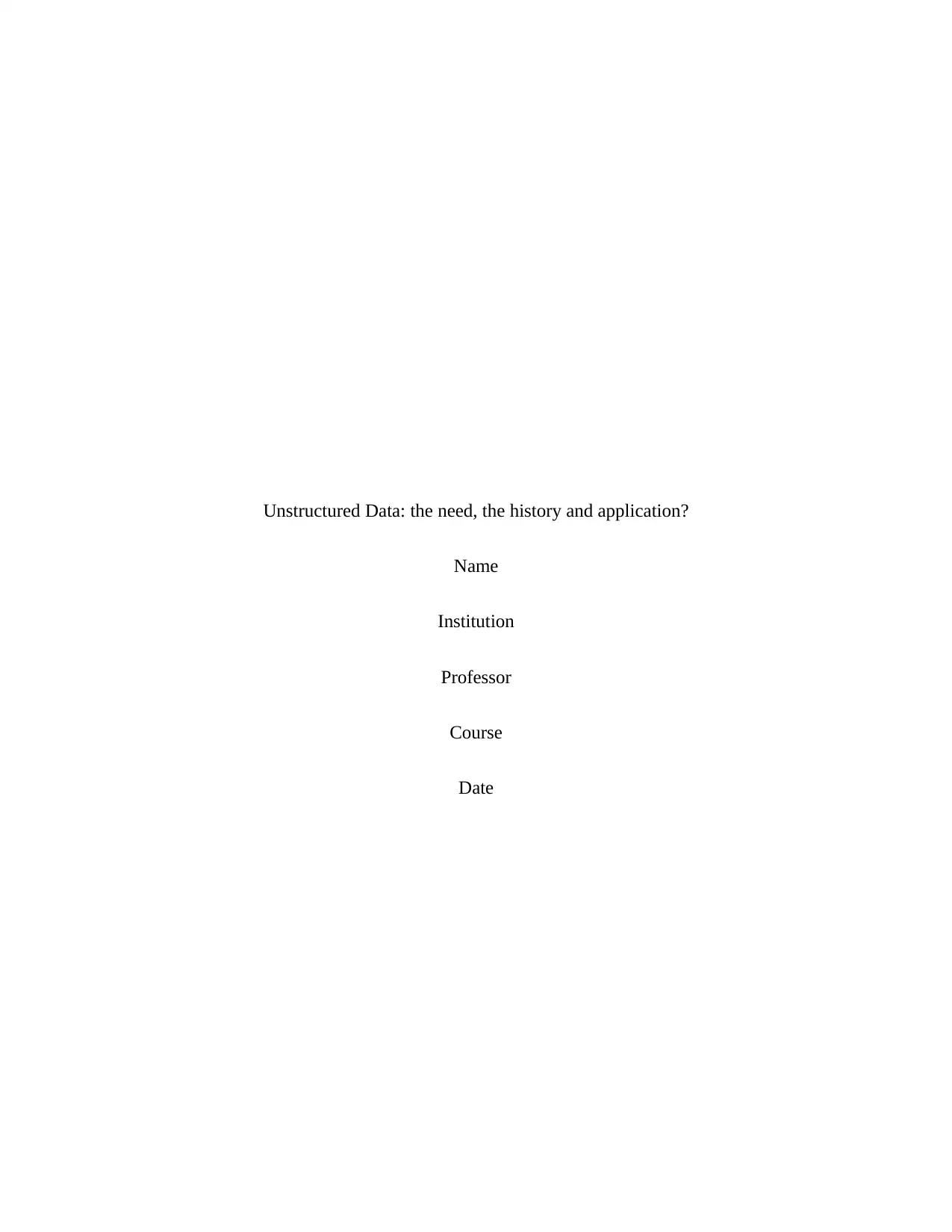
Unstructured Data: the need, the history and application?
Name
Institution
Professor
Course
Date
Name
Institution
Professor
Course
Date
Secure Best Marks with AI Grader
Need help grading? Try our AI Grader for instant feedback on your assignments.
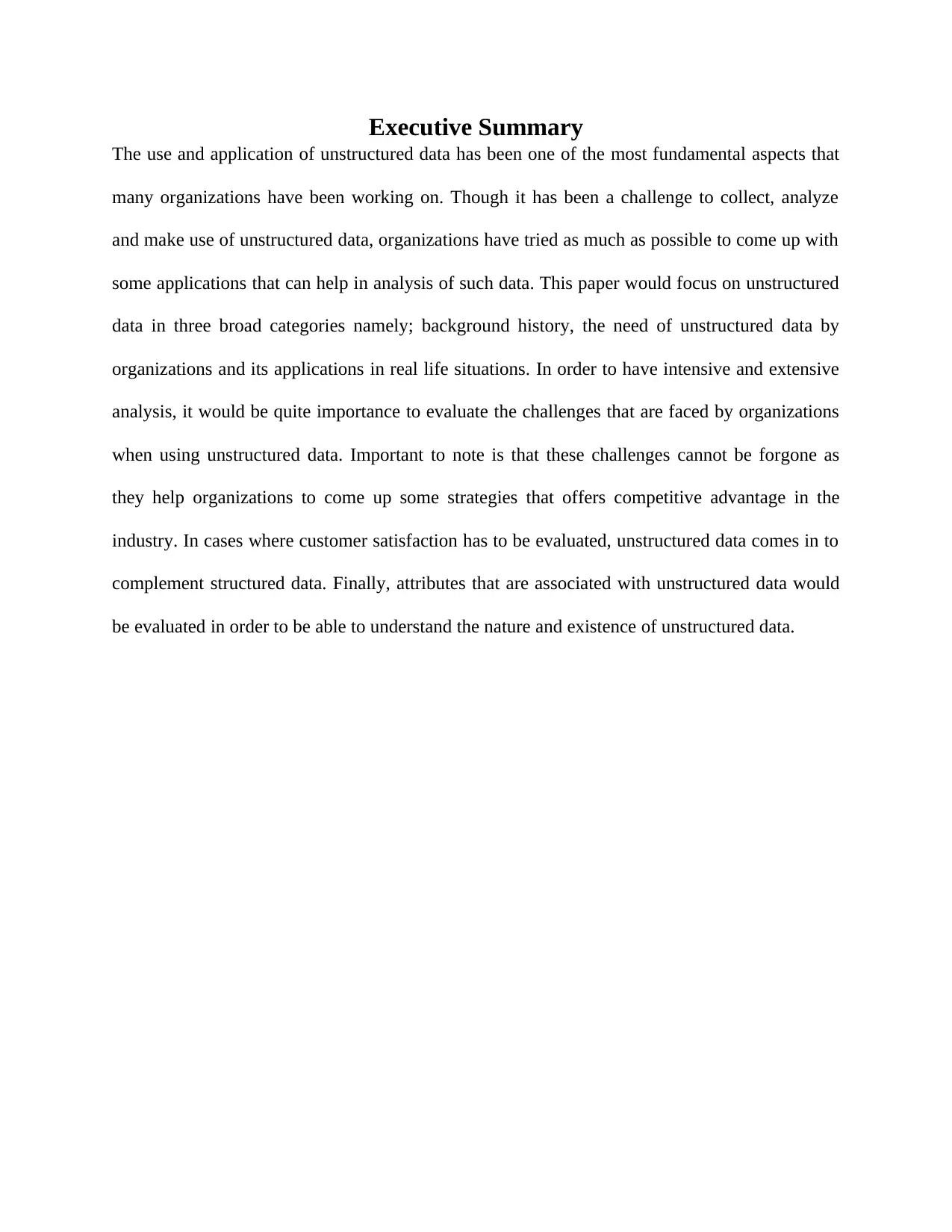
Executive Summary
The use and application of unstructured data has been one of the most fundamental aspects that
many organizations have been working on. Though it has been a challenge to collect, analyze
and make use of unstructured data, organizations have tried as much as possible to come up with
some applications that can help in analysis of such data. This paper would focus on unstructured
data in three broad categories namely; background history, the need of unstructured data by
organizations and its applications in real life situations. In order to have intensive and extensive
analysis, it would be quite importance to evaluate the challenges that are faced by organizations
when using unstructured data. Important to note is that these challenges cannot be forgone as
they help organizations to come up some strategies that offers competitive advantage in the
industry. In cases where customer satisfaction has to be evaluated, unstructured data comes in to
complement structured data. Finally, attributes that are associated with unstructured data would
be evaluated in order to be able to understand the nature and existence of unstructured data.
The use and application of unstructured data has been one of the most fundamental aspects that
many organizations have been working on. Though it has been a challenge to collect, analyze
and make use of unstructured data, organizations have tried as much as possible to come up with
some applications that can help in analysis of such data. This paper would focus on unstructured
data in three broad categories namely; background history, the need of unstructured data by
organizations and its applications in real life situations. In order to have intensive and extensive
analysis, it would be quite importance to evaluate the challenges that are faced by organizations
when using unstructured data. Important to note is that these challenges cannot be forgone as
they help organizations to come up some strategies that offers competitive advantage in the
industry. In cases where customer satisfaction has to be evaluated, unstructured data comes in to
complement structured data. Finally, attributes that are associated with unstructured data would
be evaluated in order to be able to understand the nature and existence of unstructured data.
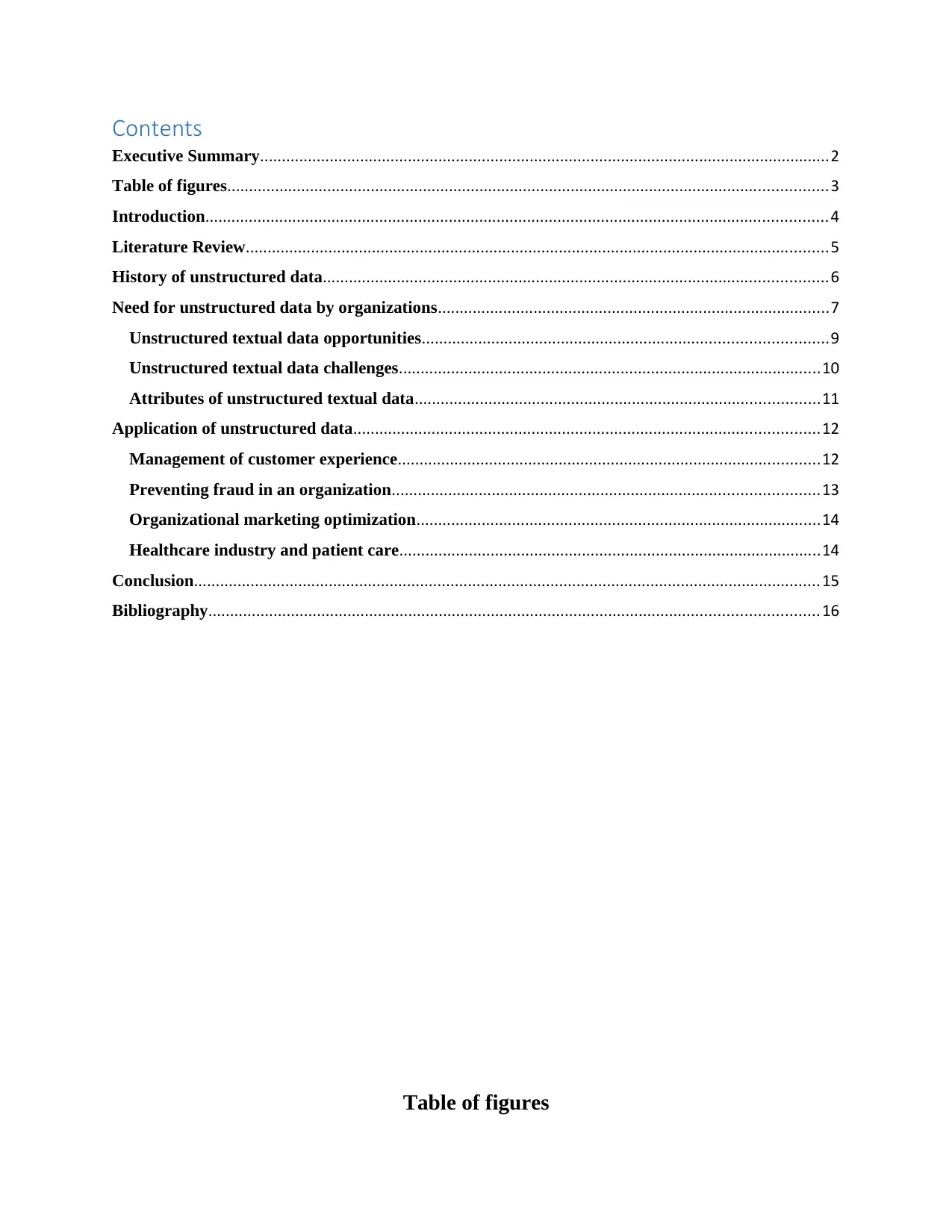
Contents
Executive Summary...................................................................................................................................2
Table of figures..........................................................................................................................................3
Introduction...............................................................................................................................................4
Literature Review......................................................................................................................................5
History of unstructured data....................................................................................................................6
Need for unstructured data by organizations..........................................................................................7
Unstructured textual data opportunities.............................................................................................9
Unstructured textual data challenges.................................................................................................10
Attributes of unstructured textual data.............................................................................................11
Application of unstructured data...........................................................................................................12
Management of customer experience.................................................................................................12
Preventing fraud in an organization..................................................................................................13
Organizational marketing optimization.............................................................................................14
Healthcare industry and patient care.................................................................................................14
Conclusion................................................................................................................................................15
Bibliography............................................................................................................................................16
Table of figures
Executive Summary...................................................................................................................................2
Table of figures..........................................................................................................................................3
Introduction...............................................................................................................................................4
Literature Review......................................................................................................................................5
History of unstructured data....................................................................................................................6
Need for unstructured data by organizations..........................................................................................7
Unstructured textual data opportunities.............................................................................................9
Unstructured textual data challenges.................................................................................................10
Attributes of unstructured textual data.............................................................................................11
Application of unstructured data...........................................................................................................12
Management of customer experience.................................................................................................12
Preventing fraud in an organization..................................................................................................13
Organizational marketing optimization.............................................................................................14
Healthcare industry and patient care.................................................................................................14
Conclusion................................................................................................................................................15
Bibliography............................................................................................................................................16
Table of figures
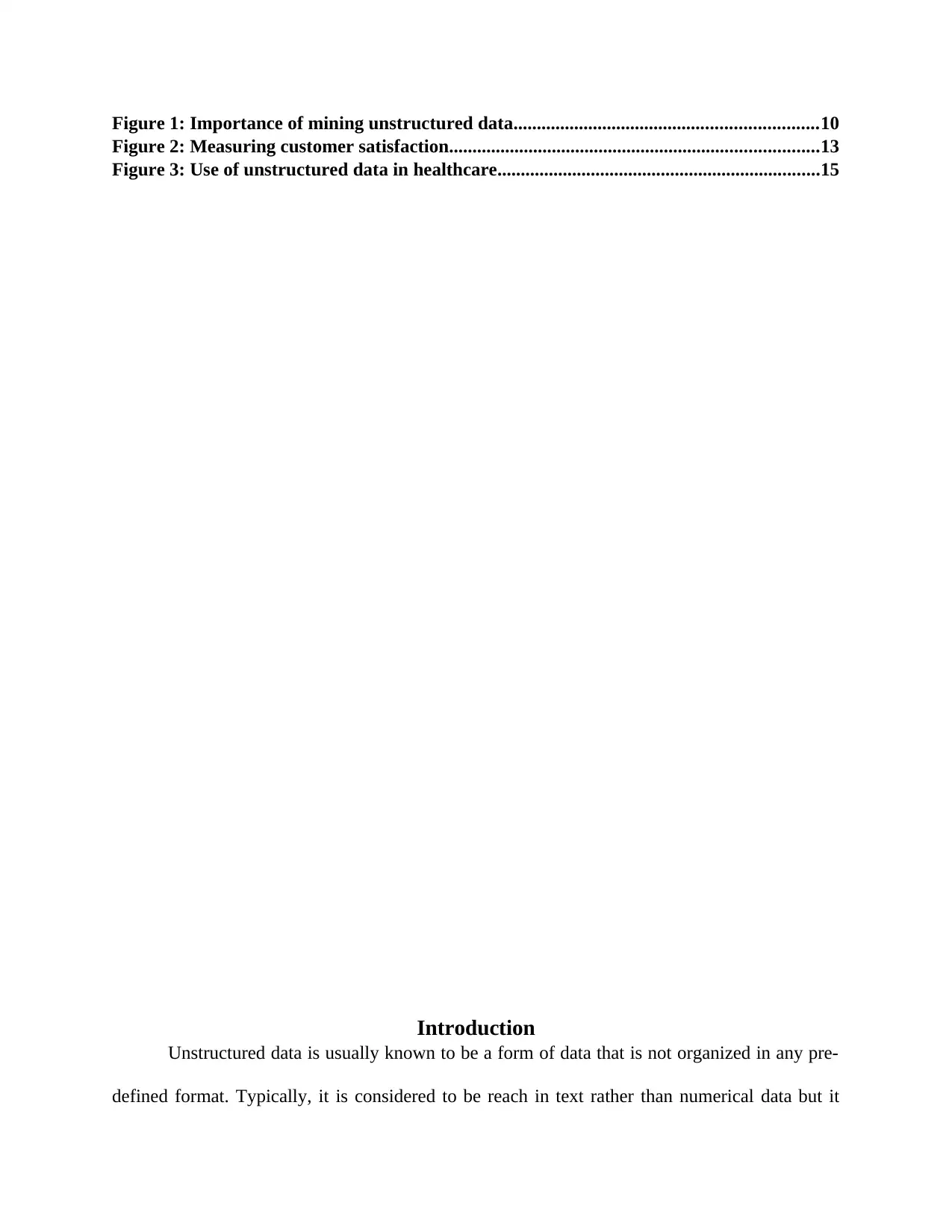
Figure 1: Importance of mining unstructured data.................................................................10
Figure 2: Measuring customer satisfaction...............................................................................13
Figure 3: Use of unstructured data in healthcare.....................................................................15
Introduction
Unstructured data is usually known to be a form of data that is not organized in any pre-
defined format. Typically, it is considered to be reach in text rather than numerical data but it
Figure 2: Measuring customer satisfaction...............................................................................13
Figure 3: Use of unstructured data in healthcare.....................................................................15
Introduction
Unstructured data is usually known to be a form of data that is not organized in any pre-
defined format. Typically, it is considered to be reach in text rather than numerical data but it
Secure Best Marks with AI Grader
Need help grading? Try our AI Grader for instant feedback on your assignments.
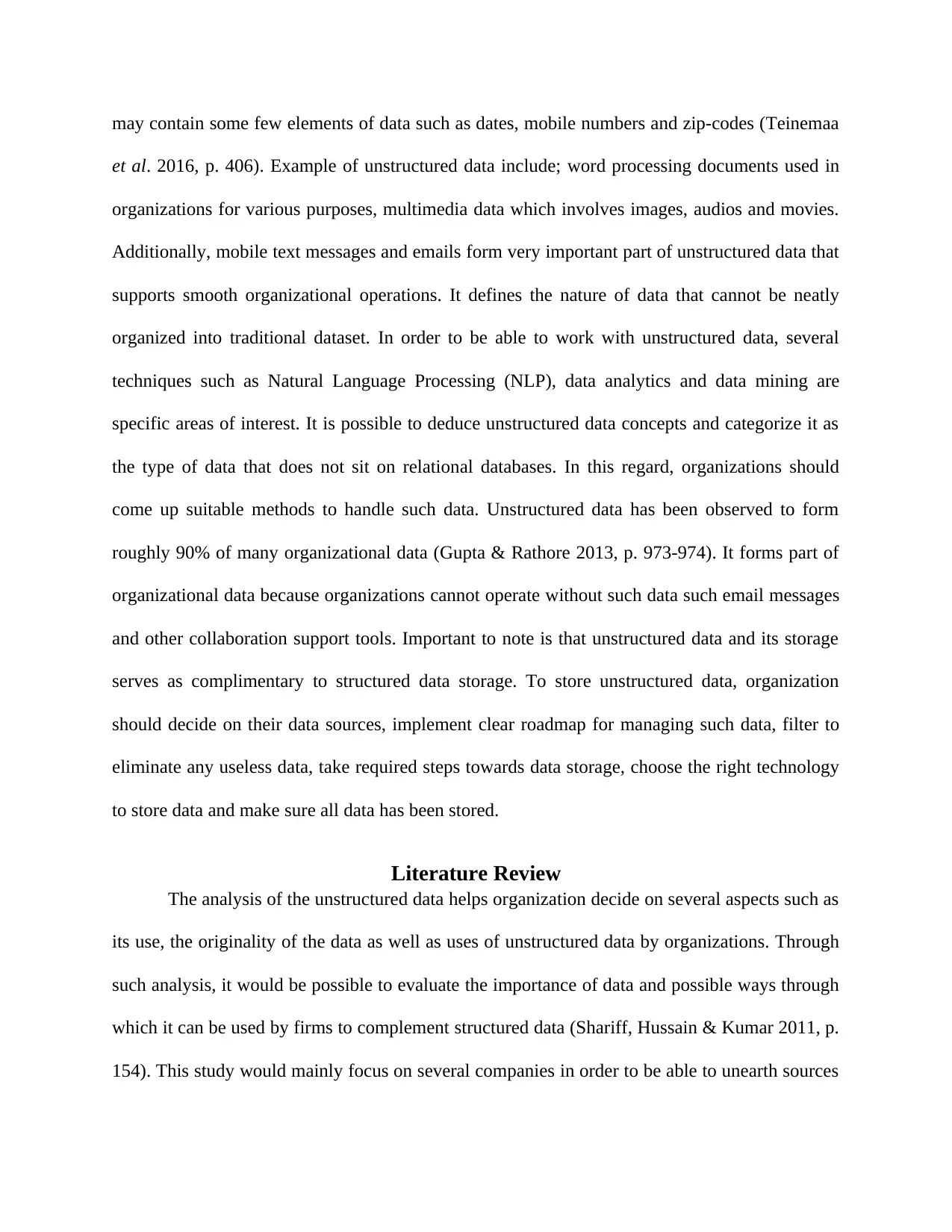
may contain some few elements of data such as dates, mobile numbers and zip-codes (Teinemaa
et al. 2016, p. 406). Example of unstructured data include; word processing documents used in
organizations for various purposes, multimedia data which involves images, audios and movies.
Additionally, mobile text messages and emails form very important part of unstructured data that
supports smooth organizational operations. It defines the nature of data that cannot be neatly
organized into traditional dataset. In order to be able to work with unstructured data, several
techniques such as Natural Language Processing (NLP), data analytics and data mining are
specific areas of interest. It is possible to deduce unstructured data concepts and categorize it as
the type of data that does not sit on relational databases. In this regard, organizations should
come up suitable methods to handle such data. Unstructured data has been observed to form
roughly 90% of many organizational data (Gupta & Rathore 2013, p. 973-974). It forms part of
organizational data because organizations cannot operate without such data such email messages
and other collaboration support tools. Important to note is that unstructured data and its storage
serves as complimentary to structured data storage. To store unstructured data, organization
should decide on their data sources, implement clear roadmap for managing such data, filter to
eliminate any useless data, take required steps towards data storage, choose the right technology
to store data and make sure all data has been stored.
Literature Review
The analysis of the unstructured data helps organization decide on several aspects such as
its use, the originality of the data as well as uses of unstructured data by organizations. Through
such analysis, it would be possible to evaluate the importance of data and possible ways through
which it can be used by firms to complement structured data (Shariff, Hussain & Kumar 2011, p.
154). This study would mainly focus on several companies in order to be able to unearth sources
et al. 2016, p. 406). Example of unstructured data include; word processing documents used in
organizations for various purposes, multimedia data which involves images, audios and movies.
Additionally, mobile text messages and emails form very important part of unstructured data that
supports smooth organizational operations. It defines the nature of data that cannot be neatly
organized into traditional dataset. In order to be able to work with unstructured data, several
techniques such as Natural Language Processing (NLP), data analytics and data mining are
specific areas of interest. It is possible to deduce unstructured data concepts and categorize it as
the type of data that does not sit on relational databases. In this regard, organizations should
come up suitable methods to handle such data. Unstructured data has been observed to form
roughly 90% of many organizational data (Gupta & Rathore 2013, p. 973-974). It forms part of
organizational data because organizations cannot operate without such data such email messages
and other collaboration support tools. Important to note is that unstructured data and its storage
serves as complimentary to structured data storage. To store unstructured data, organization
should decide on their data sources, implement clear roadmap for managing such data, filter to
eliminate any useless data, take required steps towards data storage, choose the right technology
to store data and make sure all data has been stored.
Literature Review
The analysis of the unstructured data helps organization decide on several aspects such as
its use, the originality of the data as well as uses of unstructured data by organizations. Through
such analysis, it would be possible to evaluate the importance of data and possible ways through
which it can be used by firms to complement structured data (Shariff, Hussain & Kumar 2011, p.
154). This study would mainly focus on several companies in order to be able to unearth sources
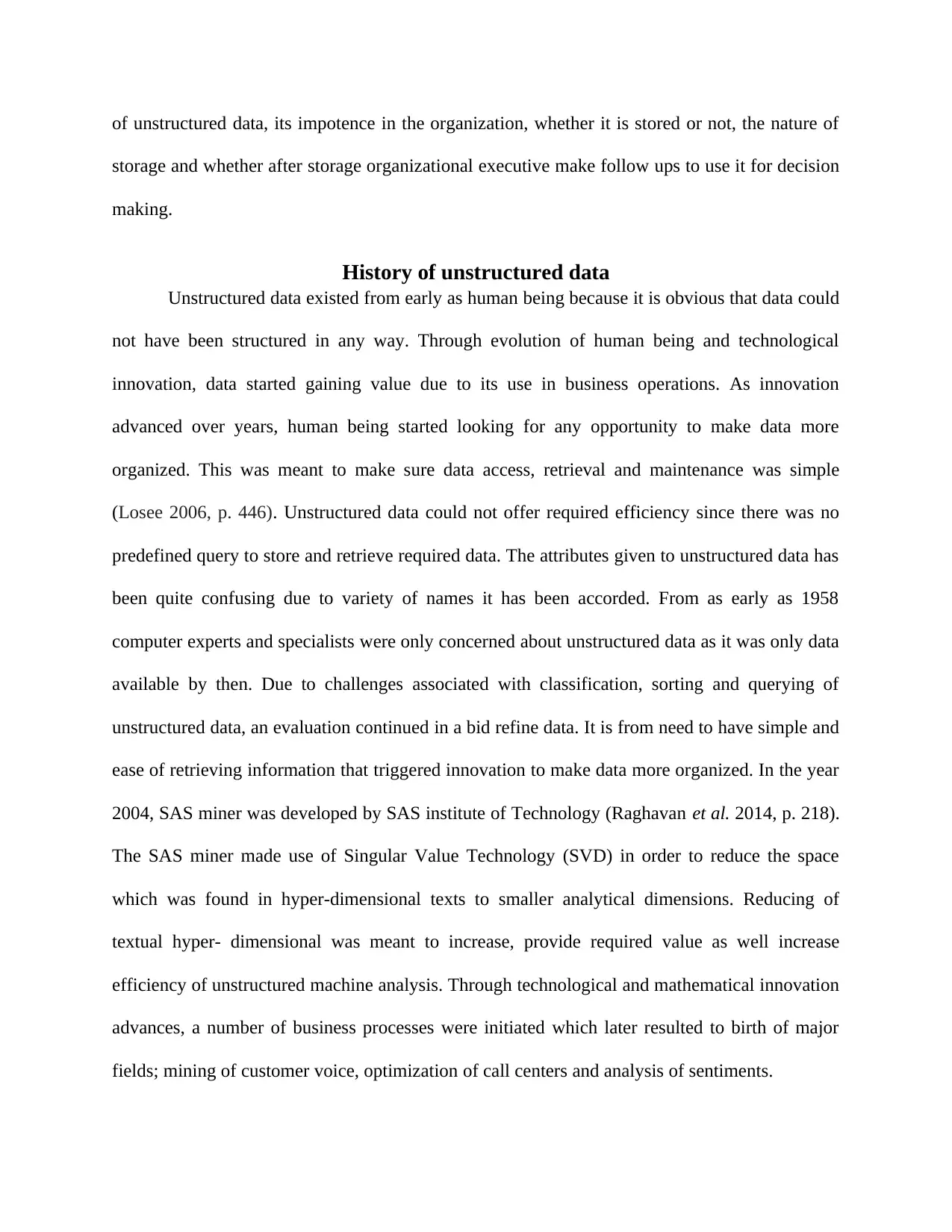
of unstructured data, its impotence in the organization, whether it is stored or not, the nature of
storage and whether after storage organizational executive make follow ups to use it for decision
making.
History of unstructured data
Unstructured data existed from early as human being because it is obvious that data could
not have been structured in any way. Through evolution of human being and technological
innovation, data started gaining value due to its use in business operations. As innovation
advanced over years, human being started looking for any opportunity to make data more
organized. This was meant to make sure data access, retrieval and maintenance was simple
(Losee 2006, p. 446). Unstructured data could not offer required efficiency since there was no
predefined query to store and retrieve required data. The attributes given to unstructured data has
been quite confusing due to variety of names it has been accorded. From as early as 1958
computer experts and specialists were only concerned about unstructured data as it was only data
available by then. Due to challenges associated with classification, sorting and querying of
unstructured data, an evaluation continued in a bid refine data. It is from need to have simple and
ease of retrieving information that triggered innovation to make data more organized. In the year
2004, SAS miner was developed by SAS institute of Technology (Raghavan et al. 2014, p. 218).
The SAS miner made use of Singular Value Technology (SVD) in order to reduce the space
which was found in hyper-dimensional texts to smaller analytical dimensions. Reducing of
textual hyper- dimensional was meant to increase, provide required value as well increase
efficiency of unstructured machine analysis. Through technological and mathematical innovation
advances, a number of business processes were initiated which later resulted to birth of major
fields; mining of customer voice, optimization of call centers and analysis of sentiments.
storage and whether after storage organizational executive make follow ups to use it for decision
making.
History of unstructured data
Unstructured data existed from early as human being because it is obvious that data could
not have been structured in any way. Through evolution of human being and technological
innovation, data started gaining value due to its use in business operations. As innovation
advanced over years, human being started looking for any opportunity to make data more
organized. This was meant to make sure data access, retrieval and maintenance was simple
(Losee 2006, p. 446). Unstructured data could not offer required efficiency since there was no
predefined query to store and retrieve required data. The attributes given to unstructured data has
been quite confusing due to variety of names it has been accorded. From as early as 1958
computer experts and specialists were only concerned about unstructured data as it was only data
available by then. Due to challenges associated with classification, sorting and querying of
unstructured data, an evaluation continued in a bid refine data. It is from need to have simple and
ease of retrieving information that triggered innovation to make data more organized. In the year
2004, SAS miner was developed by SAS institute of Technology (Raghavan et al. 2014, p. 218).
The SAS miner made use of Singular Value Technology (SVD) in order to reduce the space
which was found in hyper-dimensional texts to smaller analytical dimensions. Reducing of
textual hyper- dimensional was meant to increase, provide required value as well increase
efficiency of unstructured machine analysis. Through technological and mathematical innovation
advances, a number of business processes were initiated which later resulted to birth of major
fields; mining of customer voice, optimization of call centers and analysis of sentiments.
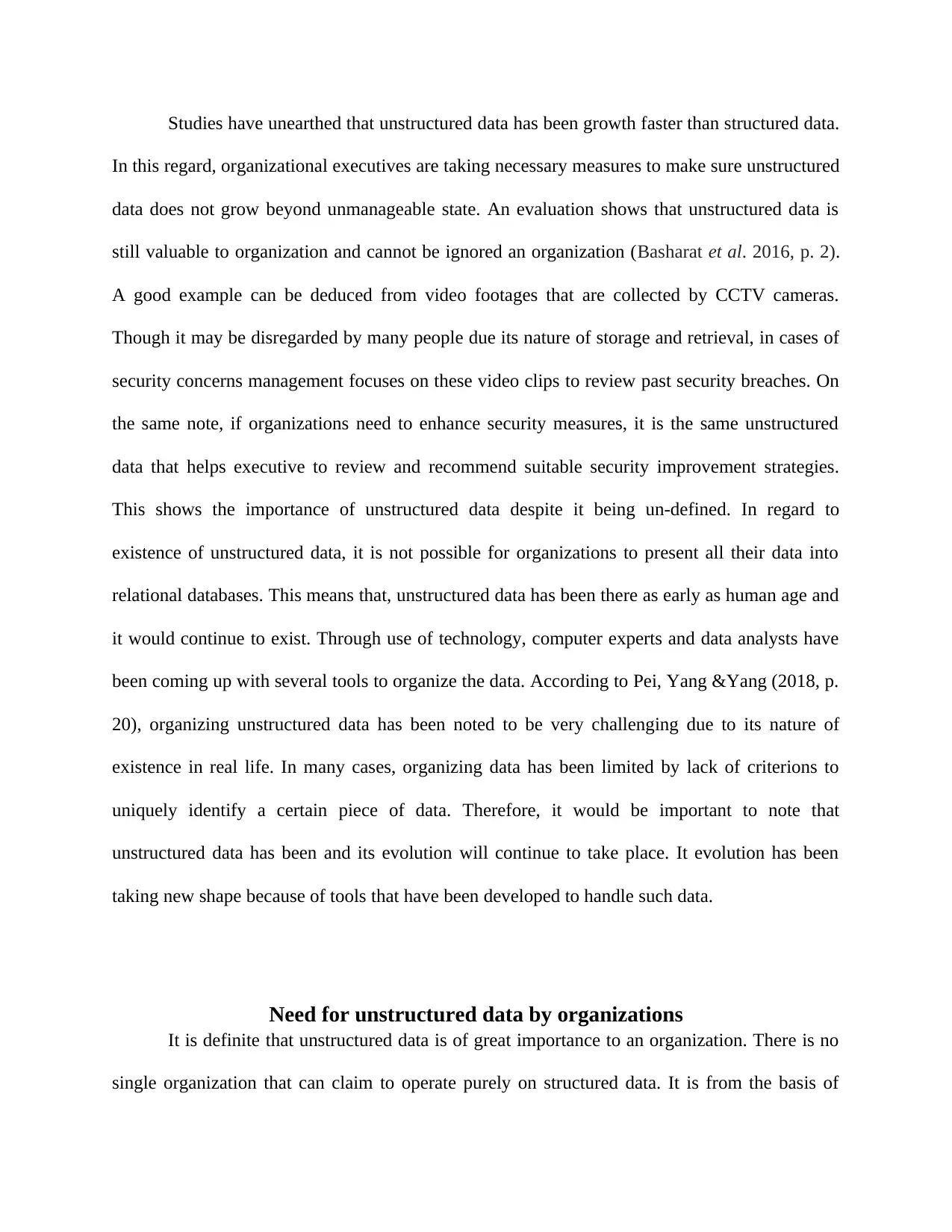
Studies have unearthed that unstructured data has been growth faster than structured data.
In this regard, organizational executives are taking necessary measures to make sure unstructured
data does not grow beyond unmanageable state. An evaluation shows that unstructured data is
still valuable to organization and cannot be ignored an organization (Basharat et al. 2016, p. 2).
A good example can be deduced from video footages that are collected by CCTV cameras.
Though it may be disregarded by many people due its nature of storage and retrieval, in cases of
security concerns management focuses on these video clips to review past security breaches. On
the same note, if organizations need to enhance security measures, it is the same unstructured
data that helps executive to review and recommend suitable security improvement strategies.
This shows the importance of unstructured data despite it being un-defined. In regard to
existence of unstructured data, it is not possible for organizations to present all their data into
relational databases. This means that, unstructured data has been there as early as human age and
it would continue to exist. Through use of technology, computer experts and data analysts have
been coming up with several tools to organize the data. According to Pei, Yang &Yang (2018, p.
20), organizing unstructured data has been noted to be very challenging due to its nature of
existence in real life. In many cases, organizing data has been limited by lack of criterions to
uniquely identify a certain piece of data. Therefore, it would be important to note that
unstructured data has been and its evolution will continue to take place. It evolution has been
taking new shape because of tools that have been developed to handle such data.
Need for unstructured data by organizations
It is definite that unstructured data is of great importance to an organization. There is no
single organization that can claim to operate purely on structured data. It is from the basis of
In this regard, organizational executives are taking necessary measures to make sure unstructured
data does not grow beyond unmanageable state. An evaluation shows that unstructured data is
still valuable to organization and cannot be ignored an organization (Basharat et al. 2016, p. 2).
A good example can be deduced from video footages that are collected by CCTV cameras.
Though it may be disregarded by many people due its nature of storage and retrieval, in cases of
security concerns management focuses on these video clips to review past security breaches. On
the same note, if organizations need to enhance security measures, it is the same unstructured
data that helps executive to review and recommend suitable security improvement strategies.
This shows the importance of unstructured data despite it being un-defined. In regard to
existence of unstructured data, it is not possible for organizations to present all their data into
relational databases. This means that, unstructured data has been there as early as human age and
it would continue to exist. Through use of technology, computer experts and data analysts have
been coming up with several tools to organize the data. According to Pei, Yang &Yang (2018, p.
20), organizing unstructured data has been noted to be very challenging due to its nature of
existence in real life. In many cases, organizing data has been limited by lack of criterions to
uniquely identify a certain piece of data. Therefore, it would be important to note that
unstructured data has been and its evolution will continue to take place. It evolution has been
taking new shape because of tools that have been developed to handle such data.
Need for unstructured data by organizations
It is definite that unstructured data is of great importance to an organization. There is no
single organization that can claim to operate purely on structured data. It is from the basis of
Paraphrase This Document
Need a fresh take? Get an instant paraphrase of this document with our AI Paraphraser
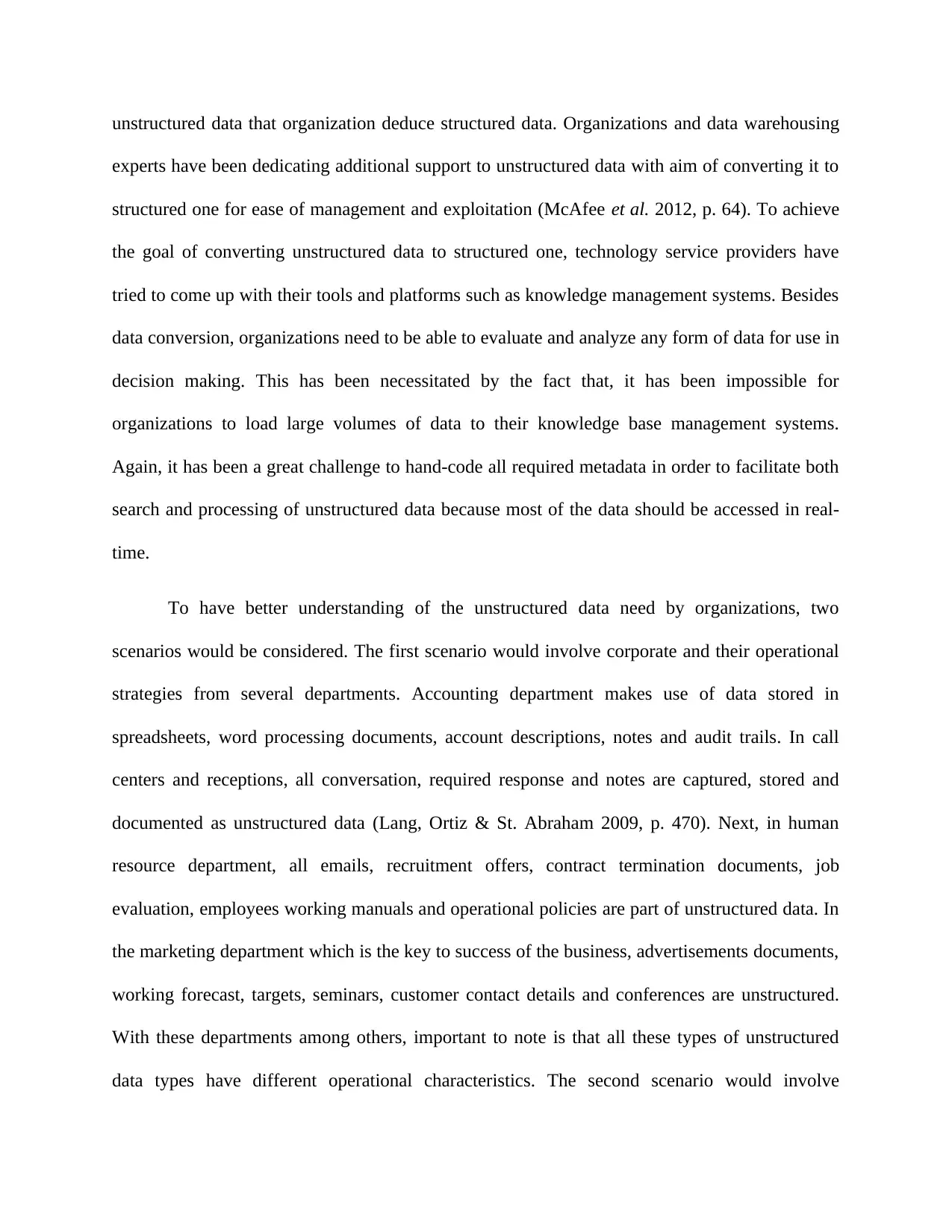
unstructured data that organization deduce structured data. Organizations and data warehousing
experts have been dedicating additional support to unstructured data with aim of converting it to
structured one for ease of management and exploitation (McAfee et al. 2012, p. 64). To achieve
the goal of converting unstructured data to structured one, technology service providers have
tried to come up with their tools and platforms such as knowledge management systems. Besides
data conversion, organizations need to be able to evaluate and analyze any form of data for use in
decision making. This has been necessitated by the fact that, it has been impossible for
organizations to load large volumes of data to their knowledge base management systems.
Again, it has been a great challenge to hand-code all required metadata in order to facilitate both
search and processing of unstructured data because most of the data should be accessed in real-
time.
To have better understanding of the unstructured data need by organizations, two
scenarios would be considered. The first scenario would involve corporate and their operational
strategies from several departments. Accounting department makes use of data stored in
spreadsheets, word processing documents, account descriptions, notes and audit trails. In call
centers and receptions, all conversation, required response and notes are captured, stored and
documented as unstructured data (Lang, Ortiz & St. Abraham 2009, p. 470). Next, in human
resource department, all emails, recruitment offers, contract termination documents, job
evaluation, employees working manuals and operational policies are part of unstructured data. In
the marketing department which is the key to success of the business, advertisements documents,
working forecast, targets, seminars, customer contact details and conferences are unstructured.
With these departments among others, important to note is that all these types of unstructured
data types have different operational characteristics. The second scenario would involve
experts have been dedicating additional support to unstructured data with aim of converting it to
structured one for ease of management and exploitation (McAfee et al. 2012, p. 64). To achieve
the goal of converting unstructured data to structured one, technology service providers have
tried to come up with their tools and platforms such as knowledge management systems. Besides
data conversion, organizations need to be able to evaluate and analyze any form of data for use in
decision making. This has been necessitated by the fact that, it has been impossible for
organizations to load large volumes of data to their knowledge base management systems.
Again, it has been a great challenge to hand-code all required metadata in order to facilitate both
search and processing of unstructured data because most of the data should be accessed in real-
time.
To have better understanding of the unstructured data need by organizations, two
scenarios would be considered. The first scenario would involve corporate and their operational
strategies from several departments. Accounting department makes use of data stored in
spreadsheets, word processing documents, account descriptions, notes and audit trails. In call
centers and receptions, all conversation, required response and notes are captured, stored and
documented as unstructured data (Lang, Ortiz & St. Abraham 2009, p. 470). Next, in human
resource department, all emails, recruitment offers, contract termination documents, job
evaluation, employees working manuals and operational policies are part of unstructured data. In
the marketing department which is the key to success of the business, advertisements documents,
working forecast, targets, seminars, customer contact details and conferences are unstructured.
With these departments among others, important to note is that all these types of unstructured
data types have different operational characteristics. The second scenario would involve
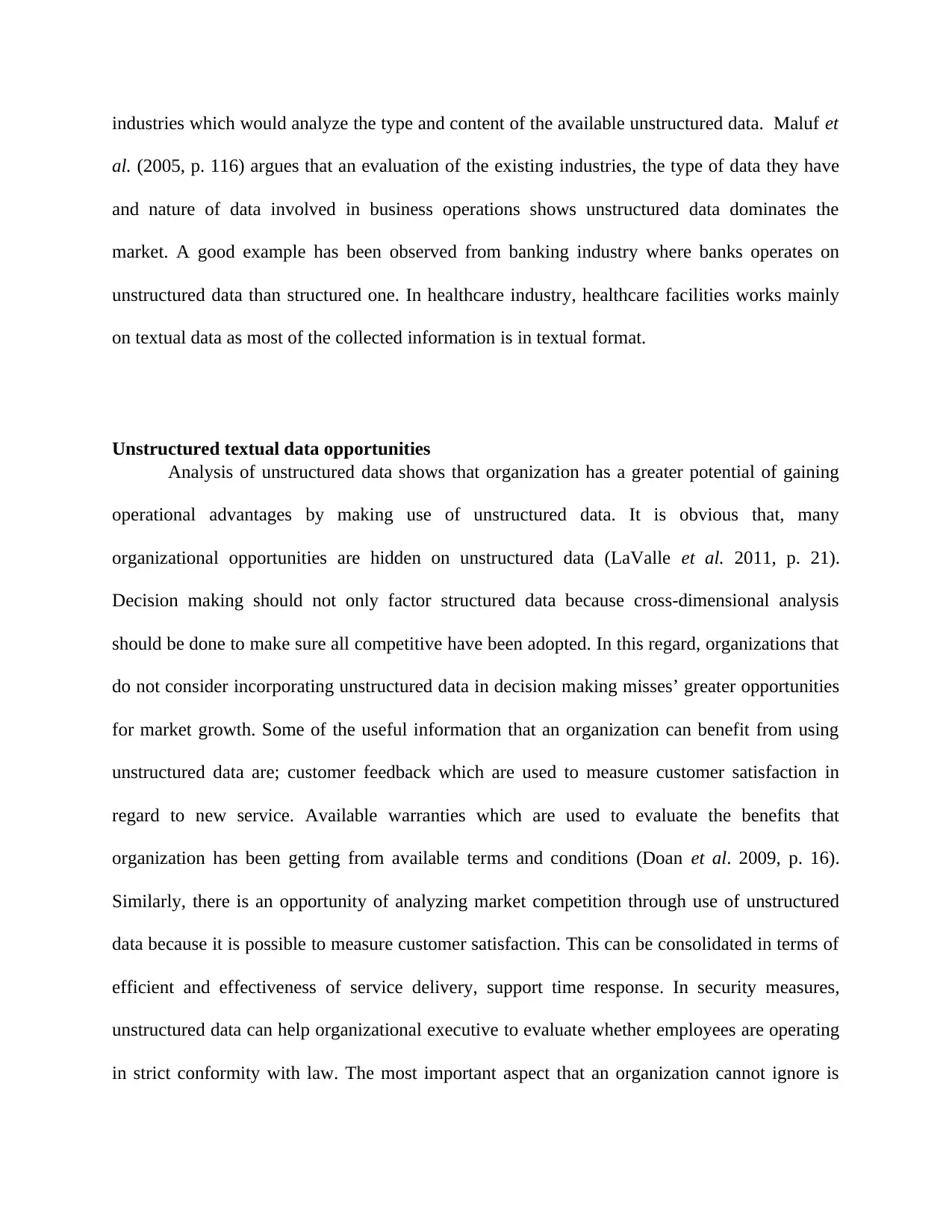
industries which would analyze the type and content of the available unstructured data. Maluf et
al. (2005, p. 116) argues that an evaluation of the existing industries, the type of data they have
and nature of data involved in business operations shows unstructured data dominates the
market. A good example has been observed from banking industry where banks operates on
unstructured data than structured one. In healthcare industry, healthcare facilities works mainly
on textual data as most of the collected information is in textual format.
Unstructured textual data opportunities
Analysis of unstructured data shows that organization has a greater potential of gaining
operational advantages by making use of unstructured data. It is obvious that, many
organizational opportunities are hidden on unstructured data (LaValle et al. 2011, p. 21).
Decision making should not only factor structured data because cross-dimensional analysis
should be done to make sure all competitive have been adopted. In this regard, organizations that
do not consider incorporating unstructured data in decision making misses’ greater opportunities
for market growth. Some of the useful information that an organization can benefit from using
unstructured data are; customer feedback which are used to measure customer satisfaction in
regard to new service. Available warranties which are used to evaluate the benefits that
organization has been getting from available terms and conditions (Doan et al. 2009, p. 16).
Similarly, there is an opportunity of analyzing market competition through use of unstructured
data because it is possible to measure customer satisfaction. This can be consolidated in terms of
efficient and effectiveness of service delivery, support time response. In security measures,
unstructured data can help organizational executive to evaluate whether employees are operating
in strict conformity with law. The most important aspect that an organization cannot ignore is
al. (2005, p. 116) argues that an evaluation of the existing industries, the type of data they have
and nature of data involved in business operations shows unstructured data dominates the
market. A good example has been observed from banking industry where banks operates on
unstructured data than structured one. In healthcare industry, healthcare facilities works mainly
on textual data as most of the collected information is in textual format.
Unstructured textual data opportunities
Analysis of unstructured data shows that organization has a greater potential of gaining
operational advantages by making use of unstructured data. It is obvious that, many
organizational opportunities are hidden on unstructured data (LaValle et al. 2011, p. 21).
Decision making should not only factor structured data because cross-dimensional analysis
should be done to make sure all competitive have been adopted. In this regard, organizations that
do not consider incorporating unstructured data in decision making misses’ greater opportunities
for market growth. Some of the useful information that an organization can benefit from using
unstructured data are; customer feedback which are used to measure customer satisfaction in
regard to new service. Available warranties which are used to evaluate the benefits that
organization has been getting from available terms and conditions (Doan et al. 2009, p. 16).
Similarly, there is an opportunity of analyzing market competition through use of unstructured
data because it is possible to measure customer satisfaction. This can be consolidated in terms of
efficient and effectiveness of service delivery, support time response. In security measures,
unstructured data can help organizational executive to evaluate whether employees are operating
in strict conformity with law. The most important aspect that an organization cannot ignore is
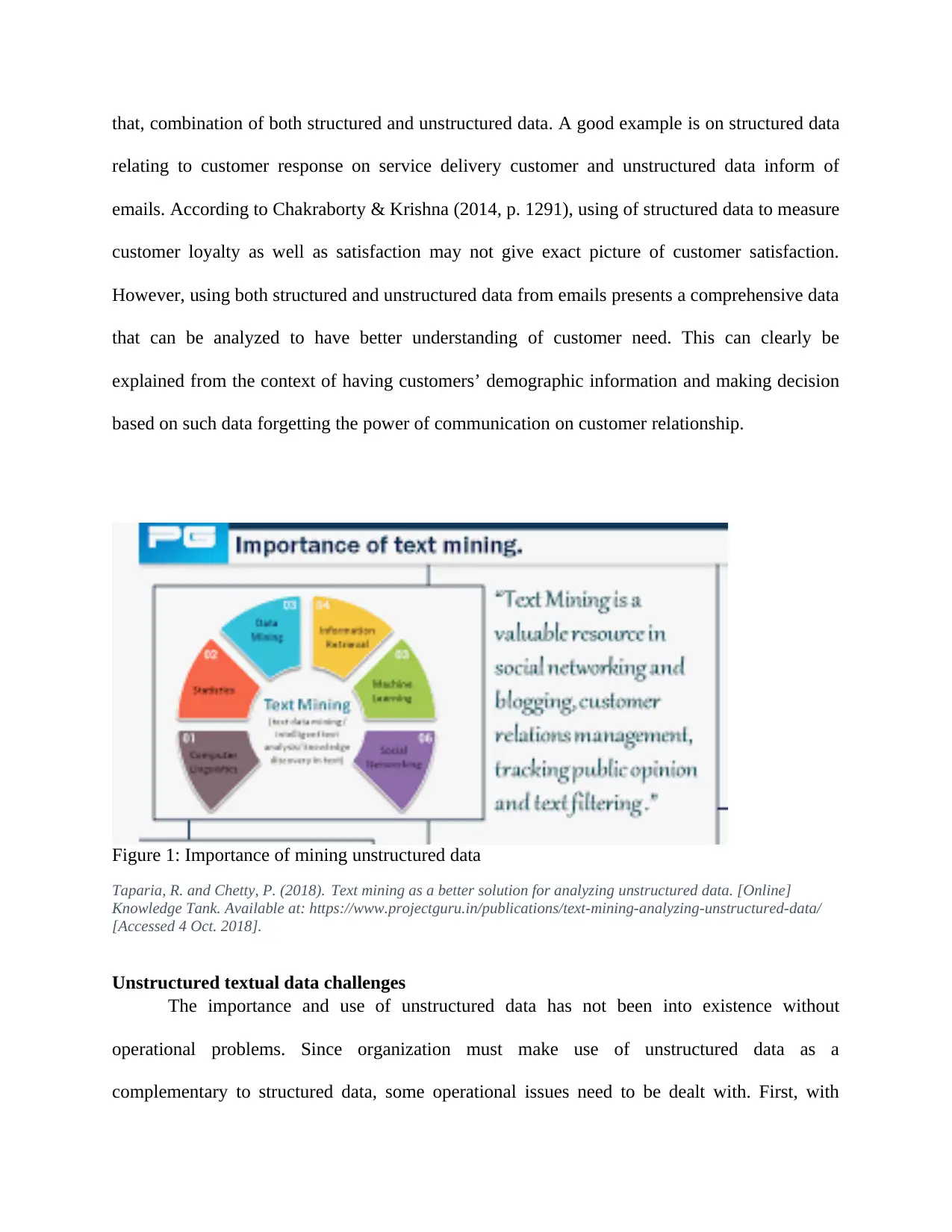
that, combination of both structured and unstructured data. A good example is on structured data
relating to customer response on service delivery customer and unstructured data inform of
emails. According to Chakraborty & Krishna (2014, p. 1291), using of structured data to measure
customer loyalty as well as satisfaction may not give exact picture of customer satisfaction.
However, using both structured and unstructured data from emails presents a comprehensive data
that can be analyzed to have better understanding of customer need. This can clearly be
explained from the context of having customers’ demographic information and making decision
based on such data forgetting the power of communication on customer relationship.
Figure 1: Importance of mining unstructured data
Taparia, R. and Chetty, P. (2018). Text mining as a better solution for analyzing unstructured data. [Online]
Knowledge Tank. Available at: https://www.projectguru.in/publications/text-mining-analyzing-unstructured-data/
[Accessed 4 Oct. 2018].
Unstructured textual data challenges
The importance and use of unstructured data has not been into existence without
operational problems. Since organization must make use of unstructured data as a
complementary to structured data, some operational issues need to be dealt with. First, with
relating to customer response on service delivery customer and unstructured data inform of
emails. According to Chakraborty & Krishna (2014, p. 1291), using of structured data to measure
customer loyalty as well as satisfaction may not give exact picture of customer satisfaction.
However, using both structured and unstructured data from emails presents a comprehensive data
that can be analyzed to have better understanding of customer need. This can clearly be
explained from the context of having customers’ demographic information and making decision
based on such data forgetting the power of communication on customer relationship.
Figure 1: Importance of mining unstructured data
Taparia, R. and Chetty, P. (2018). Text mining as a better solution for analyzing unstructured data. [Online]
Knowledge Tank. Available at: https://www.projectguru.in/publications/text-mining-analyzing-unstructured-data/
[Accessed 4 Oct. 2018].
Unstructured textual data challenges
The importance and use of unstructured data has not been into existence without
operational problems. Since organization must make use of unstructured data as a
complementary to structured data, some operational issues need to be dealt with. First, with
Secure Best Marks with AI Grader
Need help grading? Try our AI Grader for instant feedback on your assignments.

unstructured data being stored in many different formats, its accessibility must be guaranteed
whenever needed (Kassner et al. 2015, p. 38). Access can be either physical access to storage
devices or logical access in a remote manner. In this regard, data shared over the mail can be
downloaded and stored in external hard drives in a data center. Contrarily, they can be left on the
mail server for online accesses capability. The next problem is the volume of data collected and
stored in unstructured form. The primary purpose of data collection is to use it for reference
when making decision. In most of the cases, unstructured data volume is very large and its
analysis require word by word walk-through. To accomplish an analysis with such sheer volume
of data, un-daunting resources should be provided by subject organization. Additionally, the
security of unstructured data is of grave concern because they are not securely stored by many
organizations. Some of data is very sensitive and cannot be exposed to any employee. To
guarantee security of unstructured data, policy framework should be provided by executive to
provide guidelines on methodologies of data access, who should be given privileges to access it
and the nature of content to access (Mon 2013, p. 1771).
Attributes of unstructured textual data
To be able to use unstructured data in an organization, it is important to understand its
several aspects. Direct relevance of data to business operations should be considered because
revolves around critical areas such as customer credit reports, business operations legal
documentations’, insurance claims by executive airline booking and reservations (Verma et al.
2016, p. 1). Similarly, there are some other aspects not directly related to business and may
include; some communications via emails, available man power and evaluation of employees’
performance. The next attribute is on the formality of presenting unstructured data. The
organization of the message can be categorized into formal and informal depending on how it
has been presented by the relevant stakeholder. Formal unstructured data covers letters to
whenever needed (Kassner et al. 2015, p. 38). Access can be either physical access to storage
devices or logical access in a remote manner. In this regard, data shared over the mail can be
downloaded and stored in external hard drives in a data center. Contrarily, they can be left on the
mail server for online accesses capability. The next problem is the volume of data collected and
stored in unstructured form. The primary purpose of data collection is to use it for reference
when making decision. In most of the cases, unstructured data volume is very large and its
analysis require word by word walk-through. To accomplish an analysis with such sheer volume
of data, un-daunting resources should be provided by subject organization. Additionally, the
security of unstructured data is of grave concern because they are not securely stored by many
organizations. Some of data is very sensitive and cannot be exposed to any employee. To
guarantee security of unstructured data, policy framework should be provided by executive to
provide guidelines on methodologies of data access, who should be given privileges to access it
and the nature of content to access (Mon 2013, p. 1771).
Attributes of unstructured textual data
To be able to use unstructured data in an organization, it is important to understand its
several aspects. Direct relevance of data to business operations should be considered because
revolves around critical areas such as customer credit reports, business operations legal
documentations’, insurance claims by executive airline booking and reservations (Verma et al.
2016, p. 1). Similarly, there are some other aspects not directly related to business and may
include; some communications via emails, available man power and evaluation of employees’
performance. The next attribute is on the formality of presenting unstructured data. The
organization of the message can be categorized into formal and informal depending on how it
has been presented by the relevant stakeholder. Formal unstructured data covers letters to
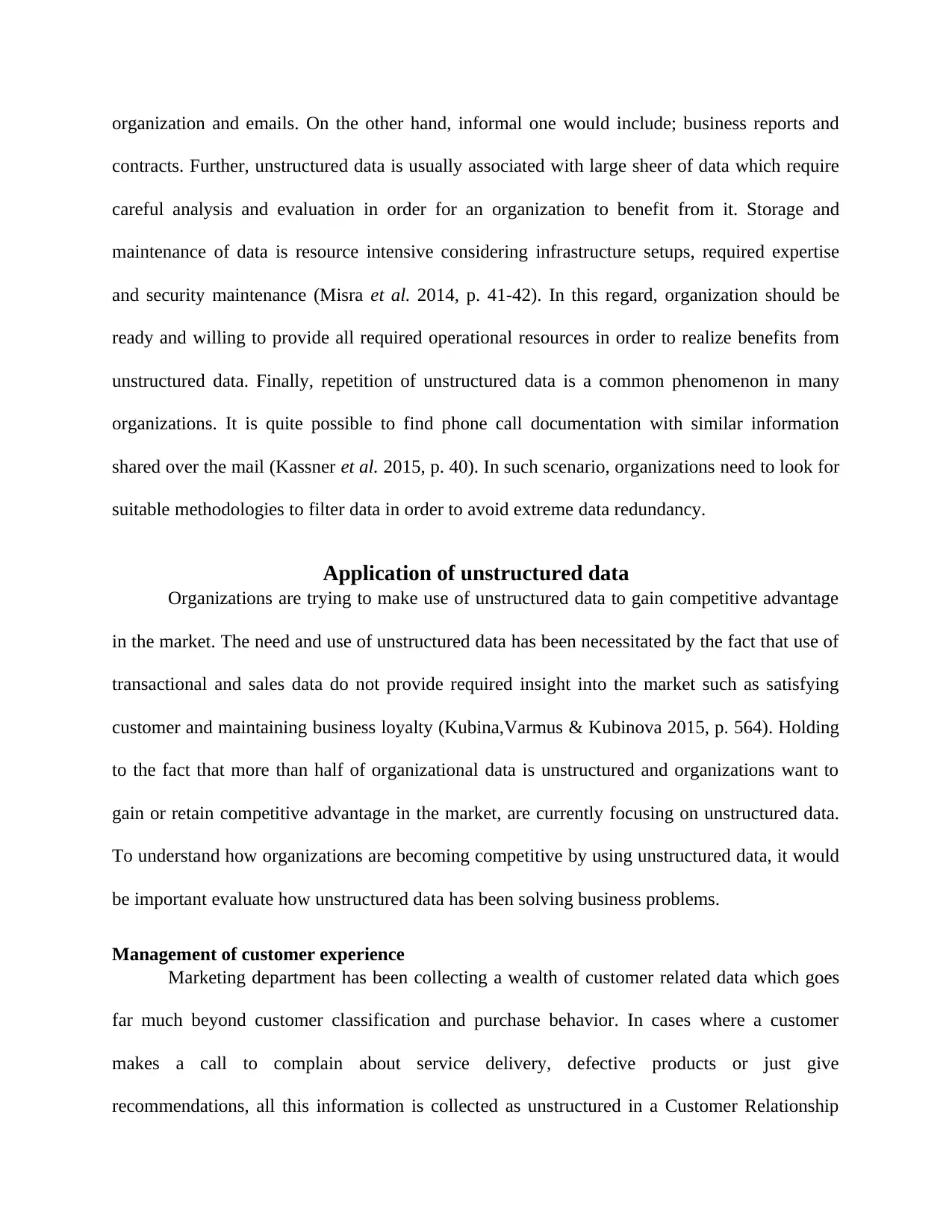
organization and emails. On the other hand, informal one would include; business reports and
contracts. Further, unstructured data is usually associated with large sheer of data which require
careful analysis and evaluation in order for an organization to benefit from it. Storage and
maintenance of data is resource intensive considering infrastructure setups, required expertise
and security maintenance (Misra et al. 2014, p. 41-42). In this regard, organization should be
ready and willing to provide all required operational resources in order to realize benefits from
unstructured data. Finally, repetition of unstructured data is a common phenomenon in many
organizations. It is quite possible to find phone call documentation with similar information
shared over the mail (Kassner et al. 2015, p. 40). In such scenario, organizations need to look for
suitable methodologies to filter data in order to avoid extreme data redundancy.
Application of unstructured data
Organizations are trying to make use of unstructured data to gain competitive advantage
in the market. The need and use of unstructured data has been necessitated by the fact that use of
transactional and sales data do not provide required insight into the market such as satisfying
customer and maintaining business loyalty (Kubina,Varmus & Kubinova 2015, p. 564). Holding
to the fact that more than half of organizational data is unstructured and organizations want to
gain or retain competitive advantage in the market, are currently focusing on unstructured data.
To understand how organizations are becoming competitive by using unstructured data, it would
be important evaluate how unstructured data has been solving business problems.
Management of customer experience
Marketing department has been collecting a wealth of customer related data which goes
far much beyond customer classification and purchase behavior. In cases where a customer
makes a call to complain about service delivery, defective products or just give
recommendations, all this information is collected as unstructured in a Customer Relationship
contracts. Further, unstructured data is usually associated with large sheer of data which require
careful analysis and evaluation in order for an organization to benefit from it. Storage and
maintenance of data is resource intensive considering infrastructure setups, required expertise
and security maintenance (Misra et al. 2014, p. 41-42). In this regard, organization should be
ready and willing to provide all required operational resources in order to realize benefits from
unstructured data. Finally, repetition of unstructured data is a common phenomenon in many
organizations. It is quite possible to find phone call documentation with similar information
shared over the mail (Kassner et al. 2015, p. 40). In such scenario, organizations need to look for
suitable methodologies to filter data in order to avoid extreme data redundancy.
Application of unstructured data
Organizations are trying to make use of unstructured data to gain competitive advantage
in the market. The need and use of unstructured data has been necessitated by the fact that use of
transactional and sales data do not provide required insight into the market such as satisfying
customer and maintaining business loyalty (Kubina,Varmus & Kubinova 2015, p. 564). Holding
to the fact that more than half of organizational data is unstructured and organizations want to
gain or retain competitive advantage in the market, are currently focusing on unstructured data.
To understand how organizations are becoming competitive by using unstructured data, it would
be important evaluate how unstructured data has been solving business problems.
Management of customer experience
Marketing department has been collecting a wealth of customer related data which goes
far much beyond customer classification and purchase behavior. In cases where a customer
makes a call to complain about service delivery, defective products or just give
recommendations, all this information is collected as unstructured in a Customer Relationship
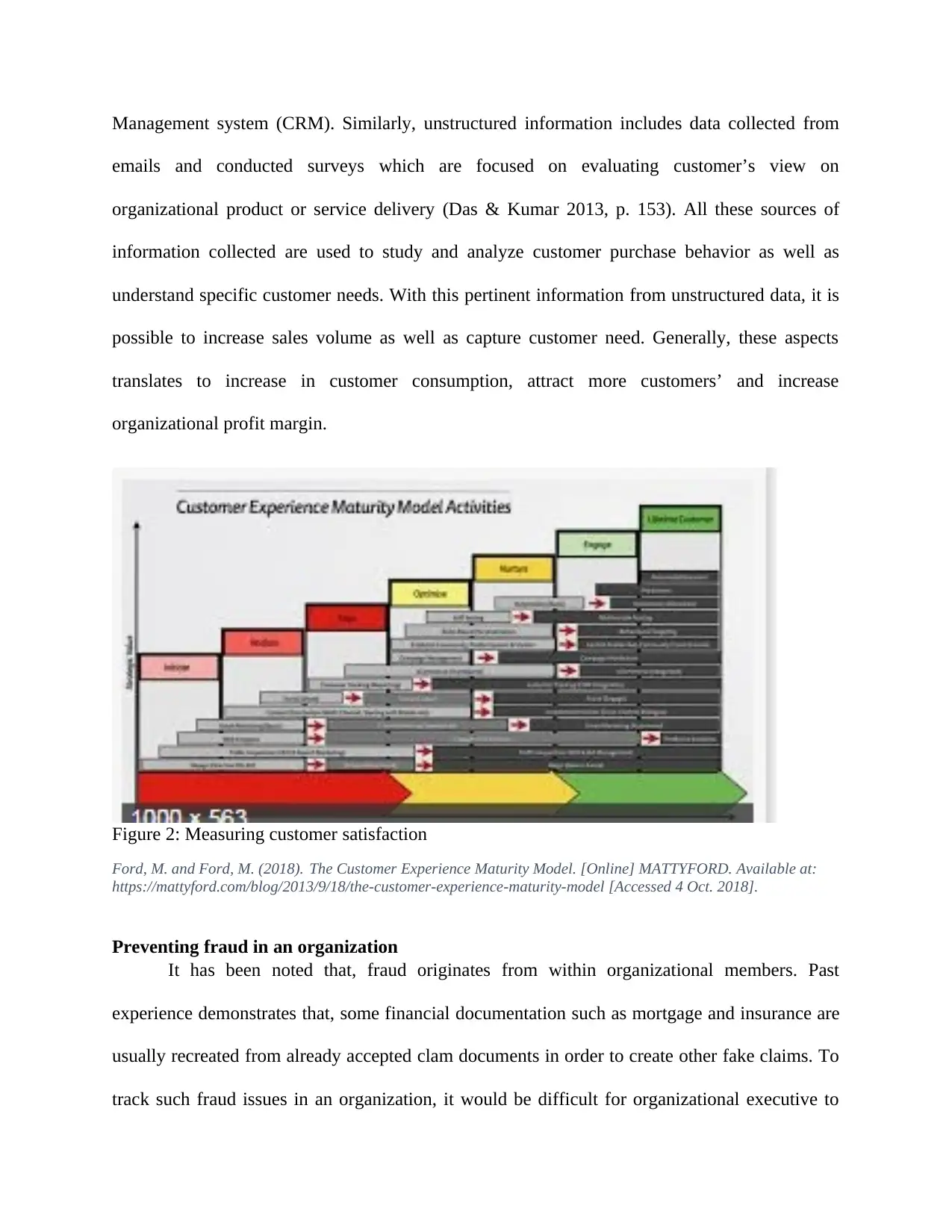
Management system (CRM). Similarly, unstructured information includes data collected from
emails and conducted surveys which are focused on evaluating customer’s view on
organizational product or service delivery (Das & Kumar 2013, p. 153). All these sources of
information collected are used to study and analyze customer purchase behavior as well as
understand specific customer needs. With this pertinent information from unstructured data, it is
possible to increase sales volume as well as capture customer need. Generally, these aspects
translates to increase in customer consumption, attract more customers’ and increase
organizational profit margin.
Figure 2: Measuring customer satisfaction
Ford, M. and Ford, M. (2018). The Customer Experience Maturity Model. [Online] MATTYFORD. Available at:
https://mattyford.com/blog/2013/9/18/the-customer-experience-maturity-model [Accessed 4 Oct. 2018].
Preventing fraud in an organization
It has been noted that, fraud originates from within organizational members. Past
experience demonstrates that, some financial documentation such as mortgage and insurance are
usually recreated from already accepted clam documents in order to create other fake claims. To
track such fraud issues in an organization, it would be difficult for organizational executive to
emails and conducted surveys which are focused on evaluating customer’s view on
organizational product or service delivery (Das & Kumar 2013, p. 153). All these sources of
information collected are used to study and analyze customer purchase behavior as well as
understand specific customer needs. With this pertinent information from unstructured data, it is
possible to increase sales volume as well as capture customer need. Generally, these aspects
translates to increase in customer consumption, attract more customers’ and increase
organizational profit margin.
Figure 2: Measuring customer satisfaction
Ford, M. and Ford, M. (2018). The Customer Experience Maturity Model. [Online] MATTYFORD. Available at:
https://mattyford.com/blog/2013/9/18/the-customer-experience-maturity-model [Accessed 4 Oct. 2018].
Preventing fraud in an organization
It has been noted that, fraud originates from within organizational members. Past
experience demonstrates that, some financial documentation such as mortgage and insurance are
usually recreated from already accepted clam documents in order to create other fake claims. To
track such fraud issues in an organization, it would be difficult for organizational executive to
Paraphrase This Document
Need a fresh take? Get an instant paraphrase of this document with our AI Paraphraser

rely on structured data only. Combination of both unstructured and structured data would be of
great importance because a comparison of available information would be done effectively to
unearth any existing disparity (Edge, Larson & White 2018, p. 2). In this regard, executive would
be able to use unstructured data to prevent loss of organizational resources. Besides,
identification of patterns from unstructured data can be used clarify all issues that are not
accurately captured from structured data. Therefore, the importance of data pattern recognition is
far much beyond financial implications to other areas such as government entities.
Organizational marketing optimization
Marketing industry has developed several text analytics applications with aim of being
able to analyze unstructured data. Organizations are able to search from multiple sources of
information such as websites, weekly published journals and press release to gain an
understanding of entire market structure (Halaweh & Massry 2015, p. 2). This helps organization
to segment available market and prioritize on the most profitable segments while developing
potential segments. The more information marketing department collects the higher the chances
of have information match in regard to customers’ need. Since marketing is categorized into
customer-based and market-based, data collected for use in these two sub-sectors have been
over-lapping. Since customer focus is known to be the key business drivers, organizations can
take advantage of consolidating its initiative to gain substantial benefits from variety of
information. This helps organization to enhance general view of customer by targeting its efforts
on customer buying habits and lifetime value.
Healthcare industry and patient care
Management of patient in healthcare industry is an important representation on use of
unstructured data. In this case, notes that complements patient records are quite useful to
healthcare professionals as they are used to identify medical history of a patient. Through use of
great importance because a comparison of available information would be done effectively to
unearth any existing disparity (Edge, Larson & White 2018, p. 2). In this regard, executive would
be able to use unstructured data to prevent loss of organizational resources. Besides,
identification of patterns from unstructured data can be used clarify all issues that are not
accurately captured from structured data. Therefore, the importance of data pattern recognition is
far much beyond financial implications to other areas such as government entities.
Organizational marketing optimization
Marketing industry has developed several text analytics applications with aim of being
able to analyze unstructured data. Organizations are able to search from multiple sources of
information such as websites, weekly published journals and press release to gain an
understanding of entire market structure (Halaweh & Massry 2015, p. 2). This helps organization
to segment available market and prioritize on the most profitable segments while developing
potential segments. The more information marketing department collects the higher the chances
of have information match in regard to customers’ need. Since marketing is categorized into
customer-based and market-based, data collected for use in these two sub-sectors have been
over-lapping. Since customer focus is known to be the key business drivers, organizations can
take advantage of consolidating its initiative to gain substantial benefits from variety of
information. This helps organization to enhance general view of customer by targeting its efforts
on customer buying habits and lifetime value.
Healthcare industry and patient care
Management of patient in healthcare industry is an important representation on use of
unstructured data. In this case, notes that complements patient records are quite useful to
healthcare professionals as they are used to identify medical history of a patient. Through use of

unstructured data, it is possible for medical practitioners to narrow down to possible ailment and
first-aid prescriptions in regard to historical patterns (Doan et al. 2009, p. 16). Similarly, digital
images can be send via mails instead of physical delivery to shorten wait in a bid to speed up
treatment. Generally, any data collected and digital images are quite useful in identification of
ailment commonalities.
Figure 3: Use of unstructured data in healthcare
McDonald, C. (2018). How Big Data is Reducing Costs and Improving Outcomes in Health Care | MapR. [Online]
Mapr.com. Available at: https://mapr.com/blog/reduce-costs-and-improve-health-care-with-big-data/ [Accessed 4
Oct. 2018].
Conclusion
Unstructured data has been in existence for long time and still continue to be an
important aspect in driving business need. Structured data was deduced from unstructured data as
computer scientist tried to look for a more organized data. Organizational use of unstructured
data cannot be doubted as it offers organization an opportunity to gain competitive advantage in
the market. Relying on structured form of data cannot guarantee any organization competitive
advantage as well as customer satisfaction. It has been proven beyond reasonable doubts that
organizational use of unstructured data offers operational advantage. Despite being unorganized,
it is a critical tool for business survival. With growth in technology, organizations have been
developing applications that can be used for unstructured data analysis in various industrial
first-aid prescriptions in regard to historical patterns (Doan et al. 2009, p. 16). Similarly, digital
images can be send via mails instead of physical delivery to shorten wait in a bid to speed up
treatment. Generally, any data collected and digital images are quite useful in identification of
ailment commonalities.
Figure 3: Use of unstructured data in healthcare
McDonald, C. (2018). How Big Data is Reducing Costs and Improving Outcomes in Health Care | MapR. [Online]
Mapr.com. Available at: https://mapr.com/blog/reduce-costs-and-improve-health-care-with-big-data/ [Accessed 4
Oct. 2018].
Conclusion
Unstructured data has been in existence for long time and still continue to be an
important aspect in driving business need. Structured data was deduced from unstructured data as
computer scientist tried to look for a more organized data. Organizational use of unstructured
data cannot be doubted as it offers organization an opportunity to gain competitive advantage in
the market. Relying on structured form of data cannot guarantee any organization competitive
advantage as well as customer satisfaction. It has been proven beyond reasonable doubts that
organizational use of unstructured data offers operational advantage. Despite being unorganized,
it is a critical tool for business survival. With growth in technology, organizations have been
developing applications that can be used for unstructured data analysis in various industrial
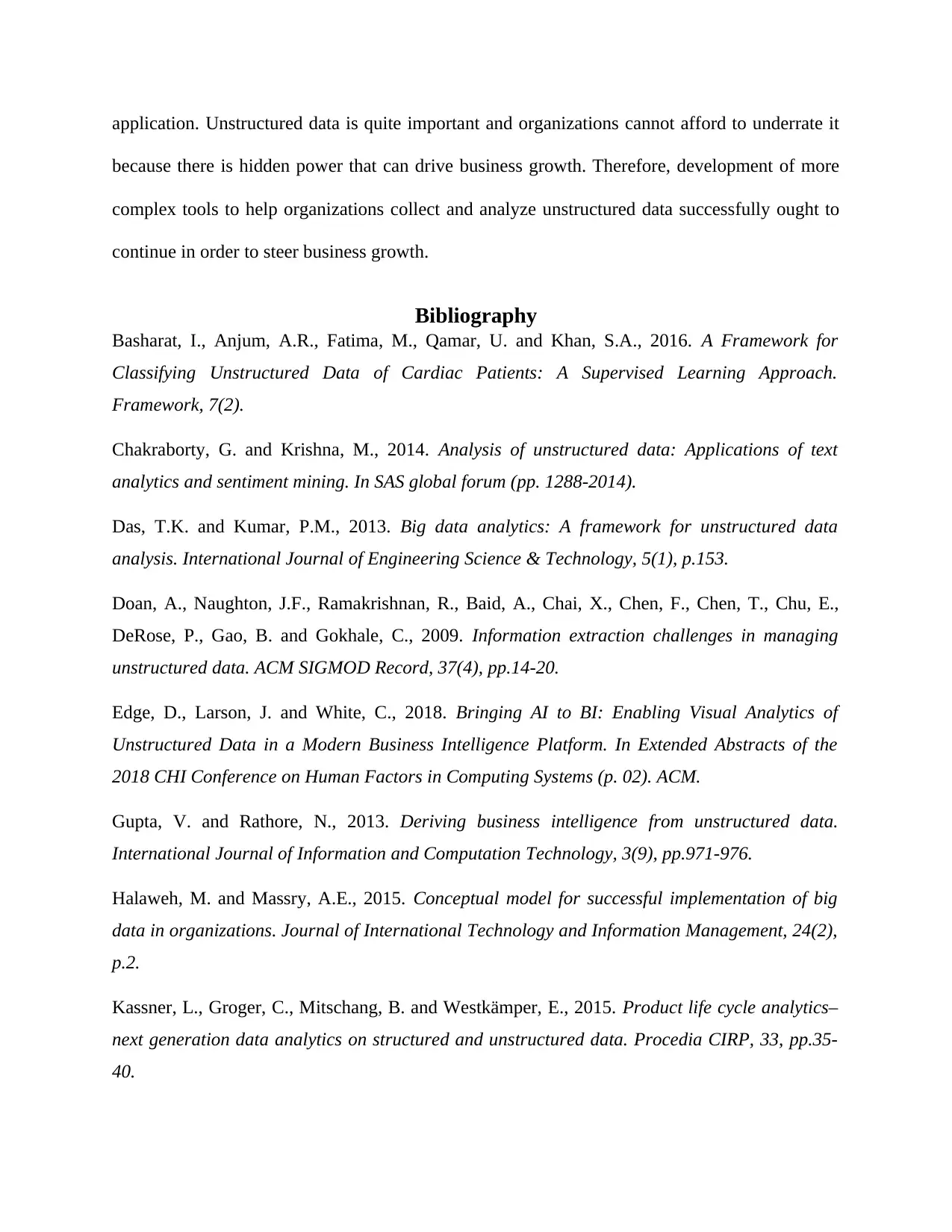
application. Unstructured data is quite important and organizations cannot afford to underrate it
because there is hidden power that can drive business growth. Therefore, development of more
complex tools to help organizations collect and analyze unstructured data successfully ought to
continue in order to steer business growth.
Bibliography
Basharat, I., Anjum, A.R., Fatima, M., Qamar, U. and Khan, S.A., 2016. A Framework for
Classifying Unstructured Data of Cardiac Patients: A Supervised Learning Approach.
Framework, 7(2).
Chakraborty, G. and Krishna, M., 2014. Analysis of unstructured data: Applications of text
analytics and sentiment mining. In SAS global forum (pp. 1288-2014).
Das, T.K. and Kumar, P.M., 2013. Big data analytics: A framework for unstructured data
analysis. International Journal of Engineering Science & Technology, 5(1), p.153.
Doan, A., Naughton, J.F., Ramakrishnan, R., Baid, A., Chai, X., Chen, F., Chen, T., Chu, E.,
DeRose, P., Gao, B. and Gokhale, C., 2009. Information extraction challenges in managing
unstructured data. ACM SIGMOD Record, 37(4), pp.14-20.
Edge, D., Larson, J. and White, C., 2018. Bringing AI to BI: Enabling Visual Analytics of
Unstructured Data in a Modern Business Intelligence Platform. In Extended Abstracts of the
2018 CHI Conference on Human Factors in Computing Systems (p. 02). ACM.
Gupta, V. and Rathore, N., 2013. Deriving business intelligence from unstructured data.
International Journal of Information and Computation Technology, 3(9), pp.971-976.
Halaweh, M. and Massry, A.E., 2015. Conceptual model for successful implementation of big
data in organizations. Journal of International Technology and Information Management, 24(2),
p.2.
Kassner, L., Groger, C., Mitschang, B. and Westkämper, E., 2015. Product life cycle analytics–
next generation data analytics on structured and unstructured data. Procedia CIRP, 33, pp.35-
40.
because there is hidden power that can drive business growth. Therefore, development of more
complex tools to help organizations collect and analyze unstructured data successfully ought to
continue in order to steer business growth.
Bibliography
Basharat, I., Anjum, A.R., Fatima, M., Qamar, U. and Khan, S.A., 2016. A Framework for
Classifying Unstructured Data of Cardiac Patients: A Supervised Learning Approach.
Framework, 7(2).
Chakraborty, G. and Krishna, M., 2014. Analysis of unstructured data: Applications of text
analytics and sentiment mining. In SAS global forum (pp. 1288-2014).
Das, T.K. and Kumar, P.M., 2013. Big data analytics: A framework for unstructured data
analysis. International Journal of Engineering Science & Technology, 5(1), p.153.
Doan, A., Naughton, J.F., Ramakrishnan, R., Baid, A., Chai, X., Chen, F., Chen, T., Chu, E.,
DeRose, P., Gao, B. and Gokhale, C., 2009. Information extraction challenges in managing
unstructured data. ACM SIGMOD Record, 37(4), pp.14-20.
Edge, D., Larson, J. and White, C., 2018. Bringing AI to BI: Enabling Visual Analytics of
Unstructured Data in a Modern Business Intelligence Platform. In Extended Abstracts of the
2018 CHI Conference on Human Factors in Computing Systems (p. 02). ACM.
Gupta, V. and Rathore, N., 2013. Deriving business intelligence from unstructured data.
International Journal of Information and Computation Technology, 3(9), pp.971-976.
Halaweh, M. and Massry, A.E., 2015. Conceptual model for successful implementation of big
data in organizations. Journal of International Technology and Information Management, 24(2),
p.2.
Kassner, L., Groger, C., Mitschang, B. and Westkämper, E., 2015. Product life cycle analytics–
next generation data analytics on structured and unstructured data. Procedia CIRP, 33, pp.35-
40.
Secure Best Marks with AI Grader
Need help grading? Try our AI Grader for instant feedback on your assignments.
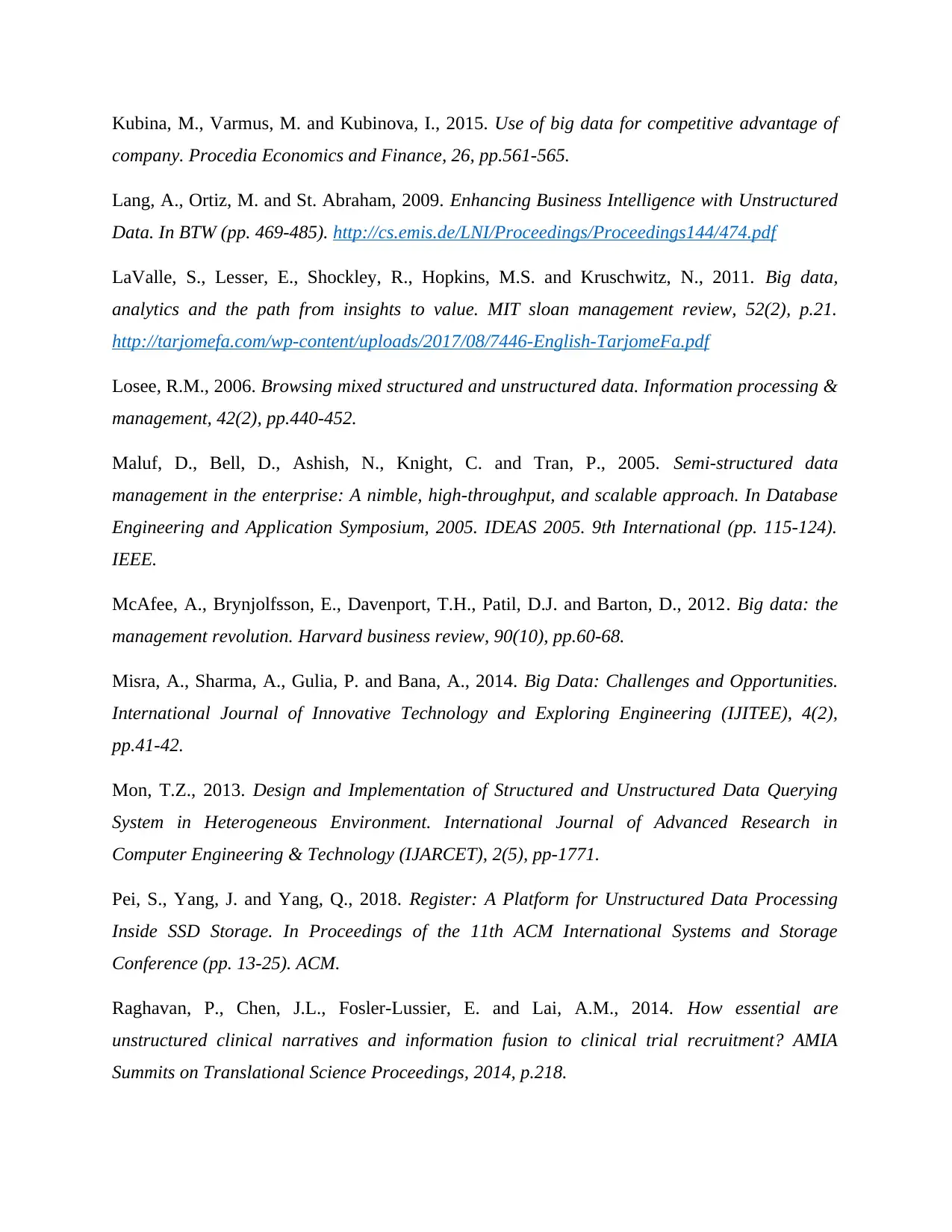
Kubina, M., Varmus, M. and Kubinova, I., 2015. Use of big data for competitive advantage of
company. Procedia Economics and Finance, 26, pp.561-565.
Lang, A., Ortiz, M. and St. Abraham, 2009. Enhancing Business Intelligence with Unstructured
Data. In BTW (pp. 469-485). http://cs.emis.de/LNI/Proceedings/Proceedings144/474.pdf
LaValle, S., Lesser, E., Shockley, R., Hopkins, M.S. and Kruschwitz, N., 2011. Big data,
analytics and the path from insights to value. MIT sloan management review, 52(2), p.21.
http://tarjomefa.com/wp-content/uploads/2017/08/7446-English-TarjomeFa.pdf
Losee, R.M., 2006. Browsing mixed structured and unstructured data. Information processing &
management, 42(2), pp.440-452.
Maluf, D., Bell, D., Ashish, N., Knight, C. and Tran, P., 2005. Semi-structured data
management in the enterprise: A nimble, high-throughput, and scalable approach. In Database
Engineering and Application Symposium, 2005. IDEAS 2005. 9th International (pp. 115-124).
IEEE.
McAfee, A., Brynjolfsson, E., Davenport, T.H., Patil, D.J. and Barton, D., 2012. Big data: the
management revolution. Harvard business review, 90(10), pp.60-68.
Misra, A., Sharma, A., Gulia, P. and Bana, A., 2014. Big Data: Challenges and Opportunities.
International Journal of Innovative Technology and Exploring Engineering (IJITEE), 4(2),
pp.41-42.
Mon, T.Z., 2013. Design and Implementation of Structured and Unstructured Data Querying
System in Heterogeneous Environment. International Journal of Advanced Research in
Computer Engineering & Technology (IJARCET), 2(5), pp-1771.
Pei, S., Yang, J. and Yang, Q., 2018. Register: A Platform for Unstructured Data Processing
Inside SSD Storage. In Proceedings of the 11th ACM International Systems and Storage
Conference (pp. 13-25). ACM.
Raghavan, P., Chen, J.L., Fosler-Lussier, E. and Lai, A.M., 2014. How essential are
unstructured clinical narratives and information fusion to clinical trial recruitment? AMIA
Summits on Translational Science Proceedings, 2014, p.218.
company. Procedia Economics and Finance, 26, pp.561-565.
Lang, A., Ortiz, M. and St. Abraham, 2009. Enhancing Business Intelligence with Unstructured
Data. In BTW (pp. 469-485). http://cs.emis.de/LNI/Proceedings/Proceedings144/474.pdf
LaValle, S., Lesser, E., Shockley, R., Hopkins, M.S. and Kruschwitz, N., 2011. Big data,
analytics and the path from insights to value. MIT sloan management review, 52(2), p.21.
http://tarjomefa.com/wp-content/uploads/2017/08/7446-English-TarjomeFa.pdf
Losee, R.M., 2006. Browsing mixed structured and unstructured data. Information processing &
management, 42(2), pp.440-452.
Maluf, D., Bell, D., Ashish, N., Knight, C. and Tran, P., 2005. Semi-structured data
management in the enterprise: A nimble, high-throughput, and scalable approach. In Database
Engineering and Application Symposium, 2005. IDEAS 2005. 9th International (pp. 115-124).
IEEE.
McAfee, A., Brynjolfsson, E., Davenport, T.H., Patil, D.J. and Barton, D., 2012. Big data: the
management revolution. Harvard business review, 90(10), pp.60-68.
Misra, A., Sharma, A., Gulia, P. and Bana, A., 2014. Big Data: Challenges and Opportunities.
International Journal of Innovative Technology and Exploring Engineering (IJITEE), 4(2),
pp.41-42.
Mon, T.Z., 2013. Design and Implementation of Structured and Unstructured Data Querying
System in Heterogeneous Environment. International Journal of Advanced Research in
Computer Engineering & Technology (IJARCET), 2(5), pp-1771.
Pei, S., Yang, J. and Yang, Q., 2018. Register: A Platform for Unstructured Data Processing
Inside SSD Storage. In Proceedings of the 11th ACM International Systems and Storage
Conference (pp. 13-25). ACM.
Raghavan, P., Chen, J.L., Fosler-Lussier, E. and Lai, A.M., 2014. How essential are
unstructured clinical narratives and information fusion to clinical trial recruitment? AMIA
Summits on Translational Science Proceedings, 2014, p.218.
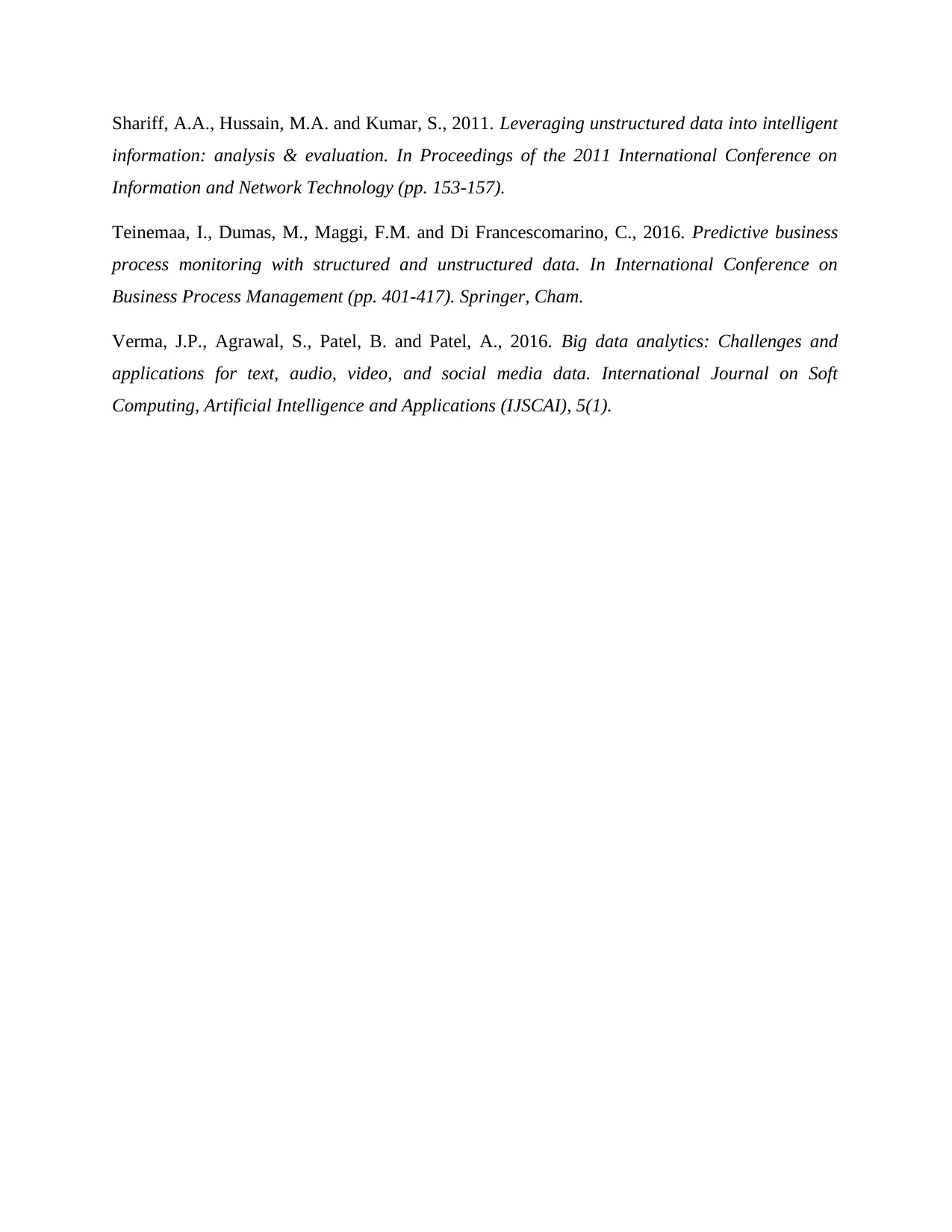
Shariff, A.A., Hussain, M.A. and Kumar, S., 2011. Leveraging unstructured data into intelligent
information: analysis & evaluation. In Proceedings of the 2011 International Conference on
Information and Network Technology (pp. 153-157).
Teinemaa, I., Dumas, M., Maggi, F.M. and Di Francescomarino, C., 2016. Predictive business
process monitoring with structured and unstructured data. In International Conference on
Business Process Management (pp. 401-417). Springer, Cham.
Verma, J.P., Agrawal, S., Patel, B. and Patel, A., 2016. Big data analytics: Challenges and
applications for text, audio, video, and social media data. International Journal on Soft
Computing, Artificial Intelligence and Applications (IJSCAI), 5(1).
information: analysis & evaluation. In Proceedings of the 2011 International Conference on
Information and Network Technology (pp. 153-157).
Teinemaa, I., Dumas, M., Maggi, F.M. and Di Francescomarino, C., 2016. Predictive business
process monitoring with structured and unstructured data. In International Conference on
Business Process Management (pp. 401-417). Springer, Cham.
Verma, J.P., Agrawal, S., Patel, B. and Patel, A., 2016. Big data analytics: Challenges and
applications for text, audio, video, and social media data. International Journal on Soft
Computing, Artificial Intelligence and Applications (IJSCAI), 5(1).

1 out of 19
Your All-in-One AI-Powered Toolkit for Academic Success.
+13062052269
info@desklib.com
Available 24*7 on WhatsApp / Email
![[object Object]](/_next/static/media/star-bottom.7253800d.svg)
Unlock your academic potential
© 2024 | Zucol Services PVT LTD | All rights reserved.

